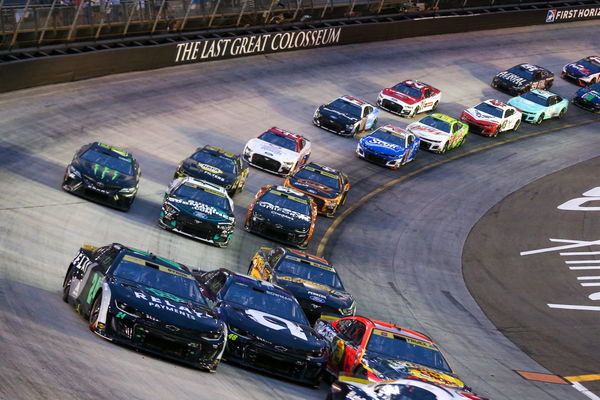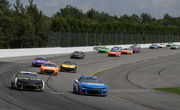
USA Today via Reuters
Sep 16, 2023; Bristol, Tennessee, USA; NASCAR Cup Series driver William Byron (24) and driver Martin Truex Jr. (19) and driver Alex Bowman (48) during the Bass Pro Shops Night Race at Bristol Motor Speedway. Mandatory Credit: Randy Sartin-USA TODAY Sports

USA Today via Reuters
Sep 16, 2023; Bristol, Tennessee, USA; NASCAR Cup Series driver William Byron (24) and driver Martin Truex Jr. (19) and driver Alex Bowman (48) during the Bass Pro Shops Night Race at Bristol Motor Speedway. Mandatory Credit: Randy Sartin-USA TODAY Sports
NASCAR Cup Series racing has undergone major changes in the modern era. It started with tweaking the format in 2017, which saw the introduction of stage breaks for the first time in the sport’s history. Like every major change, this new format met with some mixed responses and has caused controversy.
The idea behind stage racing was to allow the drivers to make strategic pit stops. And at the same time, dish out an entertaining restart, which the fans adore. Stage racing does promote a competitive ending before the field goes under yellow, but the racing community still has mixed feelings about this change in the format. Especially, with this new Next-Gen race car.
However, this change has aided NASCAR’s continued relevancy in competing against major ball-sticks sporting series. In fact, the stage racing has helped NASCAR from a business perspective.
ADVERTISEMENT
Article continues below this ad
Stage racing isn’t the doom of NASCAR Cup Series racing
Before stage racing was a thing in NASCAR, the officials rolled out their idea of a caution clock during the 2016 Craftsman Truck Series. The officials would set the timer to 20 minutes as the race went green and throw a competition caution, bringing the race to a halt. It has to be noted that NASCAR doesn’t have breaks like other major sports that allow TV partners to roll out their commercials.
So, this was sort of a strategic business decision that turned into a competitive race format the next year in 2017. The Cup Series adopted stage racing, where the short ovals and intermediate tracks had three stages. Meanwhile, marquee events and superspeedway races could have four, depending on the length. It is frustrating for the fans if the commercials abruptly interrupt the racing action. So the advent of stage racing gives the TV partner a window of opportunity to air their commercials.
It’s not just the broadcasters that get their share of the pie; stage racing also awards the drivers. The top 10 finishers of the first two stages are awarded additional championship points. These points are added to the owner-driver championship point tally. Meanwhile, the stage winner receives an additional bonus point that can be carried into the playoffs.

USA Today via Reuters
Sep 15, 2023; Bristol, Tennessee, USA; NASCAR fans watch from the pits during practice for the Bass Pro Shops Night Race at Bristol Motor Speedway. Mandatory Credit: Randy Sartin-USA TODAY Sports
For decades, there was little to no incentive for a driver to fight for a top-10 position. But with the stages, the dynamics have changed, and this has made the buildup to the playoffs more thrilling and entertaining. However, on the flip side, there are a few drawbacks to stage racing that a group of fans have long argued about, and some of the arguments are valid, to say the least.
ADVERTISEMENT
Article continues below this ad
Trending
Manufactured excitement, flawed racing strategy, and more
The biggest downside to stage racing has been the race strategy, which has become manipulative at this point. Knowing the exact time when the stage break will come allows the crew chief to split the stage for fuel and tires. Gone are those days when you had comers and goers; the only way the drivers are likely to win the race these days is by maintaining track position. And the idea of parity racing with the Gen-7 car has further fueled this trend in the modern era of NASCAR racing.
Superspeedway races have turned into a strategy game rather than a competitive affair. Most of the drivers keep hold of their track position, save fuel, and split the stages. Fuel mileage racing has plagued superspeedway racing, and this has only increased more with the Gen-7 car. The last few laps of the stage run are the times when the drivers try to force the issue, and this is only because of the points incentive.
ADVERTISEMENT
Article continues below this ad
One of the most valid points that is made during this argument is to do away with the idea of flagging the caution at the end of the stage. Fans believe that it disrupts the flow of natural races and is seen as an artificial factor to bunch the field together for restarts. It looks like NASCAR is listening to the racing community, as they have taken out competition caution during the road-course events.
As far as commercials go, the first half of the season with FOX is nothing less than torture for the fans. The race goes into the commercial break every 10 laps or so. So, there’s work to be done in the manner in which stage racing is implemented, and hopefully, NASCAR is working on overcoming these hurdles faced by the fans.
ADVERTISEMENT
ADVERTISEMENT
ADVERTISEMENT
ADVERTISEMENT






